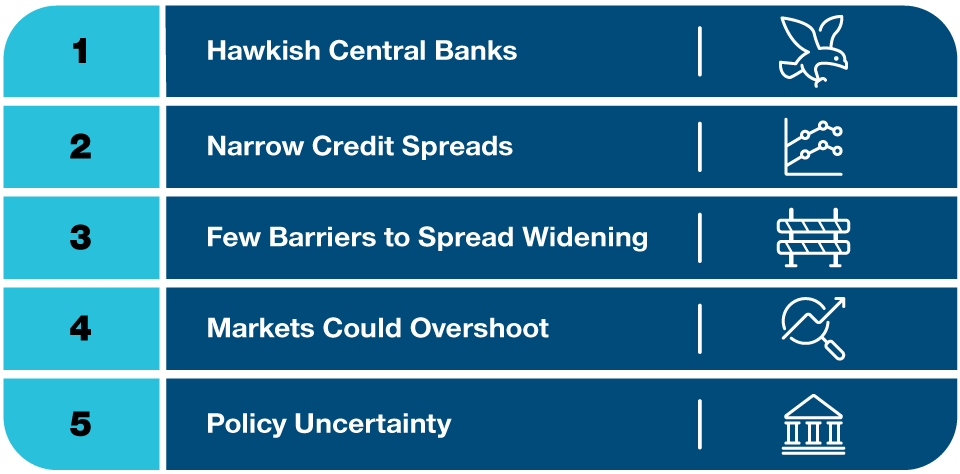February 2022 / FIXED INCOME
Five Reasons Why I’m Reducing Credit Risk
Tight spreads and hawkish central banks are a concern.
We’ve started reducing credit risk in our international and multi‑sector bond strategies. There are five main reasons for this—I discuss each in order below.
1. Yields Are Set to Rise
Inflationary pressures have broadened. Labor markets are running hot in the U.S., Canada, UK and the eurozone, and the U.S. Federal Reserve has already signaled it will begin hiking rates in March. Central banks are starting to understand that inflation is a major problem, and their current policy stances are making things worse. Depending on the central bank, more hikes have been priced in to the front end of curves over the past few months, but I worry that central banks will decide that they need to tighten the screws even more in the near term to avoid overtightening later. So policy and market momentum are skewed toward higher yields.
Five Reasons for Caution in Credit Markets
A short‑term correction is possible

2. Credit Spreads Are Too Narrow
Credit spreads are very tight by historical standards. Tight spreads are sustainable if there is: (1) a very easy policy environment and/or (2) strong, stable economic growth. This is why spreads have historically been stable or tightening during central bank hiking cycles: Central banks hiked because growth was strong, and strong growth meant that spreads were stable. It’s different now: Central banks are hiking because inflation is high, not because growth is strong. This means that policy support is being withdrawn when growth is shaky. I could be wrong about this if there is a post‑omicron growth surge or if Chinese stimulus comes through, but these feel more like wishes than predictions. So it is likely that credit spreads will have to widen to accommodate the greater risk of the next economic and policy environment.
3. There Are Few Near‑Term Restraints to Spread Widening
Central banks are rapidly winding down their quantitative easing programs. However, while market sentiment is bearish, key indicators suggest that positioning has not changed much. The consensus seems to be that a sell‑off, should it occur, will take place in the second half of the year—and so there’s little point in doing anything now. My concern is that there is probably a bit of complacency after about 22 months of fairly decent returns. Ultimately, it would probably take a combination of steadier growth, stronger valuations, and maybe even a central bank response to halt spread widening—and there’s no guarantee of those happening in the short term.
4. Markets Tend to Overshoot When Spooked
The path to supportive valuations is a long one. Although investment‑grade credit default swap index spreads are only around 15 basis points (bps) below their long‑term median, it would be very unusual for them to remain close to fair value in the event of a sell‑off—a 35–45bps widening would be more consistent with historical experience. Cash bond spreads would have even further to widen—the U.S. BBB and BB corporate spreads are currently well below their long-term average levels. It’s clear that the potential for offshoot is there.
5. Central Bank Actions Are Difficult to Predict
Central banks are now more worried about inflation than growth, which (as discussed in point 1 above) means tightening measures are inevitable. Obviously, central banks don’t want financial conditions to tighten too rapidly or in a disorderly fashion, so there is a point at which they would ease up on the tightening—the problem is, we don’t know when that would be or what it would look like. I can see, for example, the Fed delaying a rate hike by one or two meetings if credit spreads widened by 50bps—but that’s just a guess. It might do more or less. The point being: We just don’t know what central banks will do.
If my analysis above is correct, it will set up the next leg of the credit bull market. I don’t see us having a recession with short‑term U.S. rates below 1% and oil at around USD 85 a barrel, so any sell‑off in credit will probably be relatively short‑lived—say, one to two months. I want to be ready to add credit risk during a sell‑off at wider spreads. This will be easier said than done.
Important Information
This material is being furnished for general informational and/or marketing purposes only. The material does not constitute or undertake to give advice of any nature, including fiduciary investment advice. Prospective investors are recommended to seek independent legal, financial and tax advice before making any investment decision. T. Rowe Price group of companies including T. Rowe Price Associates, Inc. and/or its affiliates receive revenue from T. Rowe Price investment products and services. Past performance is no guarantee or a reliable indicator of future results.. The value of an investment and any income from it can go down as well as up. Investors may get back less than the amount invested.
The material does not constitute a distribution, an offer, an invitation, a personal or general recommendation or solicitation to sell or buy any securities in any jurisdiction or to conduct any particular investment activity. The material has not been reviewed by any regulatory authority in any jurisdiction.
Information and opinions presented have been obtained or derived from sources believed to be reliable and current; however, we cannot guarantee the sources’ accuracy or completeness. There is no guarantee that any forecasts made will come to pass. The views contained herein are as of the date written and are subject to change without notice; these views may differ from those of other T. Rowe Price group companies and/or associates. Under no circumstances should the material, in whole or in part, be copied or redistributed without consent from T. Rowe Price.
The material is not intended for use by persons in jurisdictions which prohibit or restrict the distribution of the material and in certain countries the material is provided upon specific request. It is not intended for distribution to retail investors in any jurisdiction.
USA—Issued in the USA by T. Rowe Price Associates, Inc., 100 East Pratt Street, Baltimore, MD, 21202, which is regulated by the U.S. Securities and Exchange Commission. For Institutional Investors only.
© 2024 T. Rowe Price. All Rights Reserved. T. ROWE PRICE, INVEST WITH CONFIDENCE, and the Bighorn Sheep design are, collectively and/or apart, trademarks of T. Rowe Price Group, Inc.
